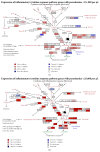Human Gene Expression in Uncomplicated Plasmodium falciparum Malaria
- PMID: 26491700
- PMCID: PMC4605373
- DOI: 10.1155/2015/162639
Human Gene Expression in Uncomplicated Plasmodium falciparum Malaria
Abstract
To examine human gene expression during uncomplicated P. falciparum malaria, we obtained three samples (acute illness, treatment, and recovery) from 10 subjects and utilized each subject's recovery sample as their baseline. At the time of acute illness (day 1), subjects had upregulation of innate immune response, cytokine, and inflammation-related genes (IL-1β, IL-6, TNF, and IFN-γ), which was more frequent with parasitemias >100,000 per μL and body temperatures ≥ 39°C. Apoptosis-related genes (Fas, BAX, and TP53) were upregulated acutely and for several days thereafter (days 1-3). In contrast, the expression of immune-modulatory (transcription factor 7, HLV-DOA, and CD6) and apoptosis inhibitory (c-myc, caspase 8, and Fas Ligand G) genes was downregulated initially and returned to normal with clinical recovery (days 7-10). These results indicate that the innate immune response, cytokine, and apoptosis pathways are upregulated acutely in uncomplicated malaria with concomitant downregulation of immune-modulatory and apoptosis inhibitory genes.
Figures




References
-
- Garnham P. C. C. Malaria Parasites and Other Haemosporidia. Oxford, UK: Blackwell Scientific; 1966.
-
- Global Health Observatory. Malaria. 2015, http://www.who.int/gho/malaria/
-
- Centers for Disease Control and Prevention. Malaria. January 2015, http://www.cdc.gov/malaria/
Publication types
MeSH terms
Grants and funding
LinkOut - more resources
Full Text Sources
Other Literature Sources
Research Materials
Miscellaneous

